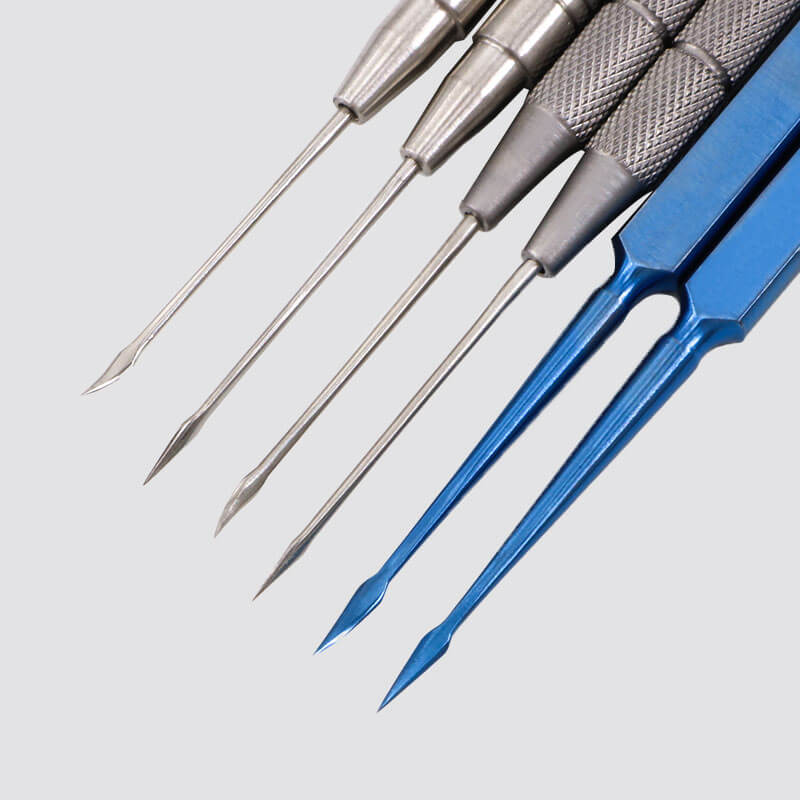Introduction to Ophthalmic Tissue Forceps
 Ophthalmic Tissue Forceps are primarily used in ophthalmic surgery to hold tissue and assist in surgical procedures. It has a unique curvature that allows it to better fit into tight surgical spaces and improves ease of operation. Ophthalmic tissue forceps are generally made of stainless steel and are usually marked with specifications for forceps use. The ophthalmic tissue forceps should be used with care to avoid damage to the tissue.
Ophthalmic Tissue Forceps are primarily used in ophthalmic surgery to hold tissue and assist in surgical procedures. It has a unique curvature that allows it to better fit into tight surgical spaces and improves ease of operation. Ophthalmic tissue forceps are generally made of stainless steel and are usually marked with specifications for forceps use. The ophthalmic tissue forceps should be used with care to avoid damage to the tissue.
What are Ophthalmic Tissue Forceps?
Ophthalmic tissue forceps are a type of surgical instrument designed specifically for the delicate and precise handling of tissues in eye surgeries. They are also commonly referred to as ophthalmic forceps or eye tissue forceps.
These forceps are typically made from high-quality stainless steel, which is known for its durability and resistance to rust and corrosion. This makes them suitable for use in sterile environments such as operating rooms. The design of ophthalmic tissue forceps is slim, lightweight, and non-intrusive, thus allowing surgeons to have a better view and control during procedures.
There are various types of ophthalmic tissue forceps with different shapes, sizes, and designs tailored to specific surgical needs. Some common types include:
1) Adson Tissue Forceps: This type has small teeth on one tip that help grasp delicate tissues without causing damage.
2) Castroviejo Tissue Forceps: These have fine jaws with grooved edges that provide additional stability when manipulating tiny structures such as sutures or vascular tissue.
3) DeBakey Tissue Forceps: It has fine tips with multiple interlocking teeth along the inner edge, making it ideal for holding slippery tissues securely.

4) Bishop Harman Tissue Forceps: This type has curved jaws with sharp serrations at the tip enabling precise grasping and manipulation of flaps or grafts during surgery.
Features of Ophthalmic Tissue Forceps
- High precision: the tips of forceps are very fine, even smaller than the diameter of red blood cells, which will not cause damage to the cornea and intraocular tissues.
- Accurate operation: Using the microscope for surgery, the forceps move precisely, which can precisely clamp the tissues or instruments and improve the efficiency of surgery.
- High safety: the surgery is performed in a closed system, reducing the possibility of contamination.
- Wide range of indications: it can be used for various eye surgeries, such as cataracts and vitreoretinopathy.
- Painless and no side effects: the surgery is performed under local anesthesia, and patients will not feel pain and discomfort.
- Fast recovery: the operation time is short and the recovery after the operation is fast.
Overall, ophthalmic tissue forceps are an efficient, safe, and precise eye surgery tool for all kinds of eye surgeries.
The Role of Ophthalmic Tissue Forceps
The role of ophthalmic tissue forceps is mainly to hold tissues, mainly used in ophthalmic surgery to forceps tissues, ophthalmic small tissue block assembly, lens and vitreous body separation. In addition, it can also be used for intraocular foreign body clamping, such as clamping and fixing suture needles, threads, cotton wool and other small objects.
When using ophthalmic tissue forceps, you need to pay attention to avoid contact with metal objects, so as not to damage the eye; strictly prohibit the closed clamping of tissues, so as not to produce pinch injury; at the same time, keep the tip of the forceps clean and smooth, in order to reduce the damage to the tissue.
Principles of Ophthalmic Tissue Forceps
The principle of ophthalmic tissue forceps mainly utilizes the mechanical property of the forceps material, i.e., elasticity. When an external force is applied to the forceps, the clamping area of the forceps produces plastic deformation, but when the external force is withdrawn, this plastic deformation can be restored, and this property can be utilized for clamping or fixation of soft tissues.
In addition, ophthalmic tissue forceps can be used with surgical microscopic instruments to provide a more realistic surgical field of view and help the surgeon perform better surgical operations. At the same time, its fine clamping ability also greatly reduces surgical injuries and improves surgical efficiency.
How to Use Ophthalmic Tissue Forceps?
- Check the forceps for cracks, wear, etc. before use to ensure the quality of the forceps.
- When holding the forceps, the index and middle fingers should be held at the tip and the thumb at the neck. Ensure that the forceps hang down naturally without gravity to avoid damage.
- Before clamping tissue, gently insert the forceps into the container, ensuring that the tip of the forceps is perpendicular to the plane of the container, and then gently and steadily clamp gently. Avoid rapid, violent clamping to prevent tissue damage.
- wash and dry the forceps after use.
- discontinue the use of forceps immediately if the head is damaged or cracked.
- avoid using forceps for purposes for which they were not designed, such as for insertion into non-tissue containers.
Please note that proper procedures should be followed during the use of ophthalmic tissue forceps to ensure proper use and safe handling.
Precautions for Ophthalmic Tissue Forceps
- check that the forceps are in good condition and are not bent or have excessive clamping force before surgery.
- The principle of aseptic operation should be strictly adhered to in order to prevent infection.
- when using forceps, pressure on the tissue should be avoided to minimize damage to the tissue.
- when clamping the tissues, the appropriate site should be selected to avoid damage to the tissues.
- blood or other tissues on the forceps should be rinsed off with sterilized saline in a timely manner after the procedure.
- forceps should be cleaned and dried after each use to prevent bacterial growth.
- forceps should be inspected and replaced periodically to ensure their quality and safety.
In conclusion, ophthalmic tissue forceps are one of the commonly used instruments in ophthalmic surgery, and the correct use and precautions can ensure the smooth progress of surgery and reduce the occurrence of complications.
Why Ophthalmic Tissue Forceps Are Essential in Eye Surgery?
Ophthalmic tissue forceps are a staple tool in eye surgery and play a crucial role in ensuring the success of the procedure. These forceps are specialized instruments designed specifically for use in delicate ophthalmic surgeries, such as cataract surgery or corneal transplants.
The primary function of ophthalmic tissue forceps is to grasp and hold onto delicate tissues within the eye during surgery. This allows the surgeon to have a precise and stable grip on tissues, making it easier to manipulate them without causing any damage.
These forceps come in various shapes and sizes depending on their intended use. Some have straight tips, while others have curved or angled tips to provide better access to different areas of the eye. They can also come with serrated or smooth jaws depending on the type of tissue they will be used on.
One of the significant advantages of using ophthalmic tissue forceps is their ability to ensure gentle handling of delicate tissues. The fine tip design and small size make it possible for surgeons to work with great precision without applying excessive pressure on fragile tissues. This gentler approach minimizes the risk of trauma and damage, which could potentially lead to complications post-surgery.
Additionally, these forceps also aid in reducing surgical time by providing efficient tissue manipulation. With their secure grip, surgeons can easily move tissues out of the way or hold them in place while performing procedures such as suturing or cutting.
Moreover, ophthalmic tissue forceps are made from high-quality materials such as stainless steel or titanium, ensuring durability and longevity. They undergo strict sterilization procedures before each use to maintain cleanliness and minimize the risk of infection during surgery.
It is essential for surgeons always to have a variety of ophthalmic tissue forceps at their disposal during eye surgeries dues to their versatile nature. From holding conjunctival flaps during trabeculectomies to manipulating intraocular lenses during cataract surgery, these forceps are crucial tools for a successful outcome.
Ophthalmic tissue forceps are an essential instrument in any eye surgery. Their delicate design and precise function make them indispensable for surgeons, allowing them to handle fragile tissues with ease and efficiency.

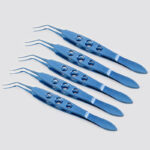 Capsulorhexis Forceps
Capsulorhexis Forceps Suture Forceps
Suture Forceps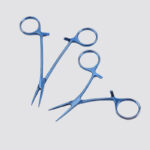 Hemostatic Forceps
Hemostatic Forceps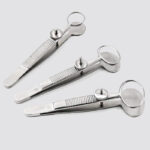 Chalazion Forceps
Chalazion Forceps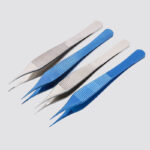 Adson Forceps
Adson Forceps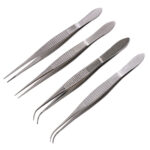 Tissue Forceps
Tissue Forceps









